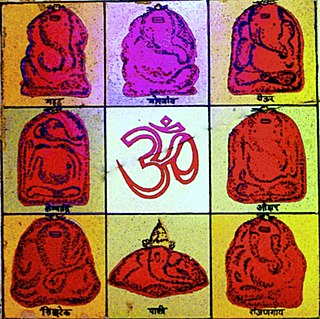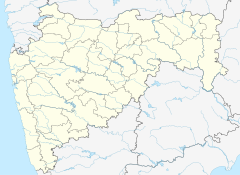
Bal Gangadhar Tilak, endeared as Lokmanya, was an Indian nationalist, teacher, and an independence activist. He was one third of the Lal Bal Pal triumvirate. The British colonial authorities called him "The father of the Indian unrest". He was also conferred with the title of "Lokmanya", which means "accepted by the people as their leader". Mahatma Gandhi called him "The Maker of Modern India".

Ashtavinayaka is a Sanskrit term which means "eight Ganeshas". The Ashtavinayaka Yatra refers to a pilgrimage to the eight Hindu temples in the state of Maharashtra, India, centered around the city of Pune. The eight temples house eight distinct idols of Ganesha, the Hindu deity of unity, prosperity, learning, and removing obstacles. Each of these temples has its own individual legend and history, as distinct from each other as the murtis in each temple. The form of each murti of Ganesha and his trunk are distinct from one another. There are other temples of eight Ganesha in various other parts of Maharashtra; however, the ones around Pune are more well known and visited. It is believed that to complete the Ashtavinayaka Yatra, one must revisit the first temple after visiting all the eight temples.

Ganesh Chaturthi, also known as Vinayak Chaturthi or Ganeshotsav, is a Hindu festival commemorating the birth of the Hindu god Ganesha. The festival is marked with the installation of Ganesha's clay idols privately in homes and publicly on elaborate pandals. Observances include chanting of Vedic hymns and Hindu texts, such as prayers and vrata (fasting). Offerings and prasada from the daily prayers, that are distributed from the pandal to the community, include sweets such as modaka as it is believed to be a favourite of Ganesha. The festival ends on the tenth day after start, when the idol is carried in a public procession with music and group chanting, then immersed in a nearby body of water such as a river or sea, called visarjan on the day of Anant Chaturdashi. In Mumbai alone, around 150,000 statues are immersed annually. Thereafter the clay idol dissolves and Ganesha is believed to return to his celestial abode.

Jijabai Bhonsle (or Bhonsale, Bhosale, Bhosle) or Jadhav, referred to as Rajmata, Rastramata, Jijabai or Jijau, was the mother of Chattrapati Shivaji, founder of the Maratha Empire. She was a daughter of Lakhujirao Jadhav of Sindkhed Raja.

Kesari is a Marathi newspaper which was founded on 4 January 1881 by Lokmanya Bal Gangadhar Tilak, a prominent leader of the Indian Independence movement. The newspaper was used as a spokes piece for the Indian national freedom movement, and continues to be published by the Kesari Maratha Trust and Tilak's descendants.
Wai is a town in Satara district of Maharashtra state in India. Located on the Krishna River, Wai was a prominent town during the Peshwa era. Two important Marathi Brahmin from ruling families had their origins here: Rani Lakshmibai of Jhansi and Gopikabai, wife of Nanasaheb Peshwa.
The Marathi people or Marathis are an Indo-Aryan ethnolinguistic group who are indigenous to Maharashtra in western India. They natively speak Marathi, an Indo-Aryan language. Maharashtra was formed as a Marathi-speaking state of India in 1960, as part of a nationwide linguistic reorganization of the Indian states. The term "Maratha" is generally used by historians to refer to all Marathi-speaking peoples, irrespective of their caste; however, now it may refer to a Maharashtrian caste known as the Maratha.
Budhwar Peth is one of many commercial localities in the old city of Pune, India. The area is located in the heart of the city has a high number of electronics shops, and is known for its red-light district. Three out of the five important Ganesh Mandals i.e. Jogeshwari Ganpati, Guruji Talim Mandal, Tulshibaug Ganpati are located here, as is Appa Balwant Chowk, known as ABC.
Indapur is a town and a municipal council in Pune district in the Indian state of Maharashtra. Indapur is known for Jahagir of Chhatrapati Shivaji Maharaj's father and grandfather. Chhatrapati Shivaji Maharaj's grandfather Malojiraje died in battle in Indapur.

Kasba Peth or Kasba is the oldest residential part, "Peth " (locality), in Pune, India. It is adjacent to the historic Shaniwar Wada palace-fort. Kasba Peth was the first Peth to be established sometime during the 5th century, and is the oldest area in Pune. It is called the "Heart of Pune City". In the history of Pune, the city was once known as "Kasbe Pune".
The Dashabhuja Temple is a Hindu temple in Pune, in the Maharashtra state of India. This temple was once owned by Sardar Haripant Phadke, a Sardar of Peshwa and was later donated to the Peshwas as dowry. Dashabhuja Ganapati temple is visited by thousands of devotees every day and the number increases during Ganesh Chaturthi. The idol of Ganpati or Ganesh seen here has his elephant trunk resting on his right-hand side, which is supposed to be rarer and more sacred than other forms of the Ganesh idol.
Pune is the 9th most populous city in India and one of the largest in the state of Maharashtra. The history of the city is closely related to the rise of the Maratha empire from the 17th–18th century. During the 18th century, Pune became the political centre of the Indian subcontinent; as the seat of the Peshwas, who were the prime ministers of the Maratha Empire.

The Dagadusheth Halwai Ganapati temple is a Hindu Temple located in Pune and is dedicated to the Hindu god Ganesh. The temple is visited by over hundred thousand pilgrims every year. Devotees of the temple include celebrities and chief ministers of Maharashtra who visit during the annual ten-day Ganeshotsav festival. The main Ganesh idol is insured for sum of ₹10 million (US$130,000). It celebrated 130 years of its Ganapati in 2022.

Ranjangaon Ganpati is one among the Ashtavinayak, celebrating eight instances of legends related to Ganesha. This temple's Ganpati idol was inaugurated and donated by the "Khollam" family, a goldsmith family based in Ranjangaon. The temple was built between the 9th and 10th century. The main temple looks like it was built in the Peshwa period. Nagarkhana is situated above the entrance gate. The temple facing east has huge and beautiful entrance gate.
Tulshibaug is an area in Pune City in the state of Maharashtra, India. It is located in the old city area. Its main features are a historic temple precinct and a large market.
Sadashiv Peth is an area located in Pune, in Maharashtra State of the Republic of India. It was founded by Madhavrao Peshwa in honour of Sadashivrao Peshwa.

The Laxmi Narsimha Temple is a Hindu temple dedicated to Lord Narasimha, an Avatar of Vishnu, located in western India, in Pune district of the state of Maharashtra. The temple is located at the confluence of Bhima river and Nira river, at the south eastern tip of Pune district, in Indapur taluka. Shri Narsimha of Nira Narsingpur is the family deity of many people from Maharashtra the prominent ones being the families of the previous Chief Minister of Maharashtra, Shri Devendra Fadnavis, Vinchurkar family, Argade family, Mitragotri family, Devale family and the illustrous kakade Gharana














